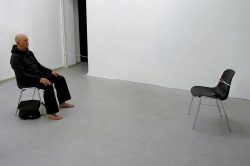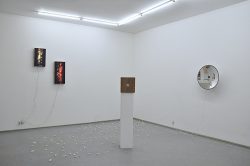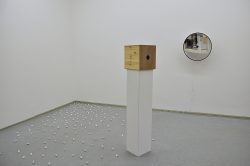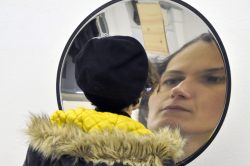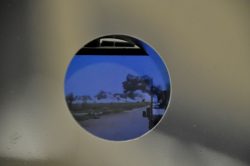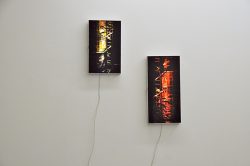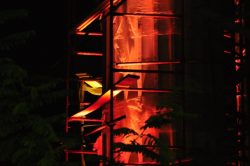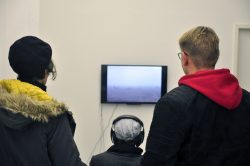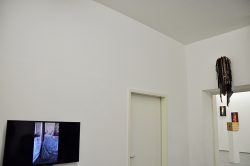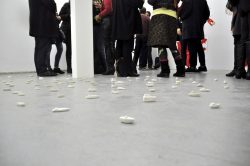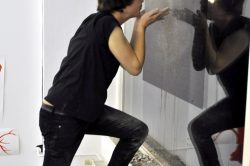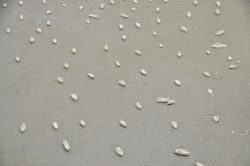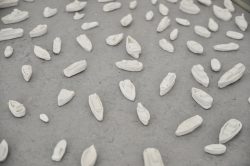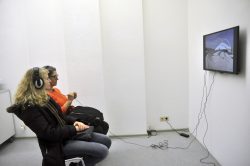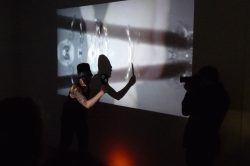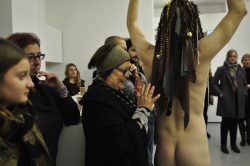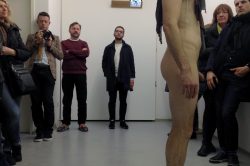tactileBOSCH Berlin: BLACK + BLUE
OCTOBER 30 – NOVEMBER 21 2015
curated by Tereza de Arruda
black + blue is an exhibition by Welsh and Wales-based artists Phil Babot, Jan Bennett, Andrew Cooper, Bob Gelsthorpe, Richard Gravelle, Beth Greenhalgh, Paul Hurley, Nicholas Lawrence & Simon Mitchell, Iwan Ap Huw Morgan, Jason Pinder, Sara Rees, Helene Roberts, Simkins & Belton, and Liz Waterhouse.
An artist led collective, tactileBOSCH operated as a free-thinking creative environment for experienced and emerging practitioners alike, showcasing experimental, multimedia and cutting edge artwork in a post-industrial gallery setting. Inhabiting a 200 hundred year-old Victorian laundry building in Cardiff, Wales from 2000-2012, tactileBOSCH developed artists’ studios, exhibition spaces, international exchanges and a reputation for unique and memorable multi-platform exhibitions.
In 2013 the laundry building was destroyed by fire, but the collective continued to build on their already rich and complex dialogue between artist, audiences and spaces by inhabiting and transforming a range of venues and sites, from the semi-derelict to the pristine. Co-founder Kim Fielding, a Cardiffian who had also lived in San Francisco and New York, used to describe the ethos of tactileBOSCH as ‘the fist inside the velvet glove’. Behind his charming and persuasive persona was a deep and serious commitment to experimentation, collaboration and originality.
When in early 2014 Kim suddenly passed away, his many friends and fellow tactileBOSCH-ers came together in this spirit of mutual support and collaboration to mount ‘Paradise Lost’, a large-scale site-specific exhibition that served as both an homage to Kim and to launch a new award in his name. This process has consolidated a core group of artists keen to continue Kim’s work in championing multi-media, performance and experimental art. They have lost their original building and an irreplaceable friend and colleague; they are bruised and battered, black and blue. Still reeling from the blow but back on their feet, and in fighting form – BISH! BASH! BOSCH!
Given this history, it is no surprise that black + blue is shot through with themes of loss, memory, and trauma. But there is also healing, resilience and transformation. Perhaps it is here that new possibilities emerge; dancing amongst the ruins, we discover new ways to live.
Building on its successful opening in late October, tactileBOSCH returns to Berlin for the exhibition’s finissage event, presenting three new performance works from established Welsh artists.
black + blue is an alchemical exhibition, shot through with the play of dualities – light and dark, life and death, dust and gold, love and destruction, male and female, apocalyptic and elegiac, broken and resplendent, bruised and dancing. The title black + blue refers to the challenges that we all face in times of significant transformation, and themes of loss, memory, and trauma run through and beneath the works. But more importantly there is also healing, resilience and renewal, and it is here that new potentials and possibilities emerge. We arise from extirpation battered and bruised, black and blue, but as we dance amongst the ruins we also discover new ways to live.
Iwan Ap Huw Morgan has studied the ritual practises of ancient Mexican peoples including the Olmec, Toltec and Aztec, and his new performance piece focuses on the physical body as a vehicle that carries with it the memories and traumas of self-destruction. Through the expression of haunting vocalisations, physical movement and unmasking, new truths are revealed during a ritual transformation.
Beth Greenhalgh’s performance work deals with loss, dystopias, utopias, other worlds, ritual, things that were, foraging, dreams, and endings. Her new work is based on a particular set of ruins, linking myth, loss and ritual. A series of sculptural pieces rely on her body to exhibit them, and through wearing the ruin on her body she carries the burden and weight of its symbolic history.
Phil Babot’s work emphasises stillness as a way of highlighting beauty in the mundane, focussing attention on the extraordinary in the everyday. His new piece centres on the former divisions created by the Berlin Wall and its dissolution leading to unification. By aligning himself along an east-west axis, he has chosen to look towards the future to confront the present and acknowledge the past.

